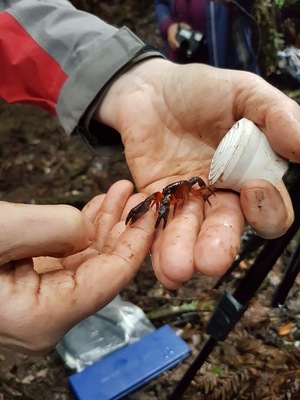You may have never heard of it, but the Dandenong Ranges Burrowing Crayfish is not an urban myth.
In fact, it’s alive and well, living in the headwaters of Emerald Creek, and a recent survey has shown a healthy number of the small-endangered invertebrate in the Dandenong Ranges.
As part of the Yarra Ranges Council Biohubs grant, the Community Weed Alliance (CWAD) of the Dandenongs, along with Yarra Ranges Council undertook a survey over the past two weeks to find this tiny, elusive, crustacean.
The crayfish was first reported in 1969 and again in the 1980s and 1990s, though it was only successfully found upstream of Falls Road on Olinda Creek in 2016.
Committee Member of CWAD, Jane Hollands said the species does not live in the creek, but next to it, in a secretive underground world of burrows.
“It was fantastic to find these endangered crayfish,” Mr Hollands said.
“In the first week we found two in the headwaters of Rundells Creek on Private land and then the second week they found two more.”
“What’s very interesting is they live underground and they leave holes in the ground, which we call chimneys and are little clusters in the soil.”
“They live in the muddy areas near the headwaters … the chances of seeing one is fairly limited as they don’t usually come up.”
The chances of seeing one are so limited that an expert from DELWP was required to help identify the burrowing cray, which is no easy task given the specimen has some tricky morphological features to other crayfish.
“They’re very hard to identify, because there is four or five species that are very similar,” Ms Hollands said.
“We can identify habitat where these animals might live, but finding them and proving that they do is very hard.”
Weed invasion is the most prominent threat to the endangered crayfish.
Ms Hollands said the survey will assist the Council in targeting weed control where the crayfish are known to occur.
“They are a threatened species and they need to be looked after in a better way, so showing that they are there is an important step in protecting them.”







